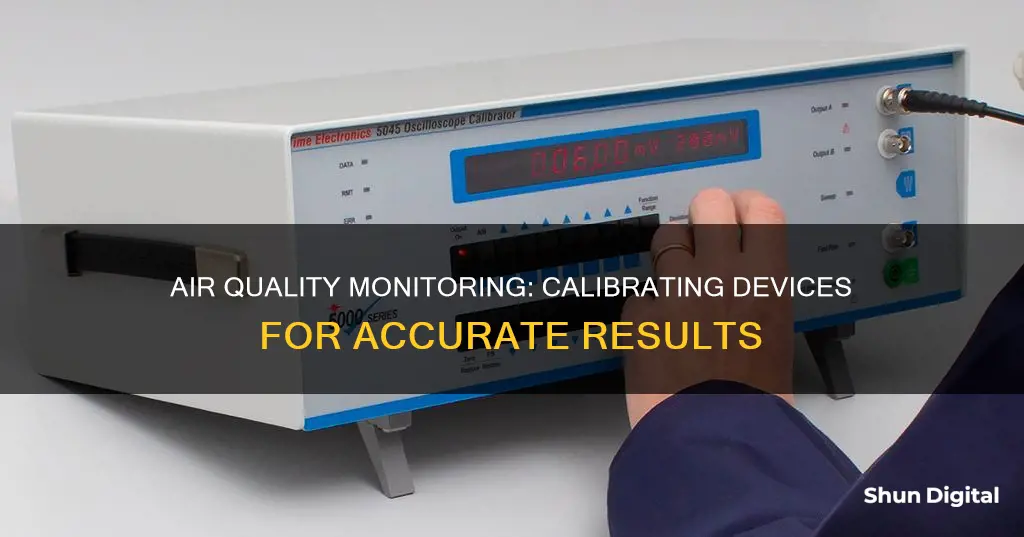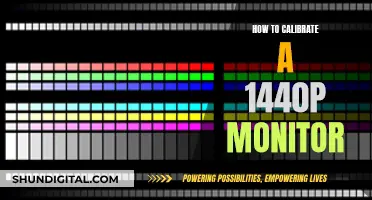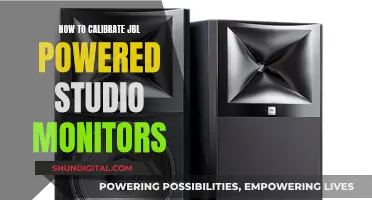
Calibration is essential for maintaining the accuracy and reliability of air monitoring devices. However, the frequency of calibration can vary depending on several factors. Different types of sensors, such as nondispersive infrared (NDIR) and electrochemical sensors, may have different calibration requirements. Environmental conditions, accuracy requirements, and manufacturer recommendations also play a role in determining the calibration interval. For example, extreme temperatures, high humidity, or exposure to pollutants may require more frequent calibration to maintain accurate readings. While some entities, like OSHA, recommend calibrating air monitoring devices before each use, manufacturers' guidelines might suggest less frequent calibration, ranging from every three to six months. Ultimately, regular calibration ensures the proper functioning of these devices and helps maintain the safety of workers in various industries.
| Characteristics | Values |
|---|---|
| Calibration frequency | Depends on the instrument use. If the device has been exposed to high gas concentrations or unusual conditions, it is recommended to perform a bump test or calibration. |
| Calibration is recommended at least every six months for reliable performance. | |
| The calibration cycle can be extended for gas monitoring instruments that pass the bump test prior to use. | |
| Calibration cost | A full calibration for a 4-gas monitor requires about $6.60 worth of calibration gas. |
| Calibration time | A full calibration for a 4-gas monitor takes about 5 minutes. |
| Bump test | A faster way to check the calibration of a device. Indicates whether the device is working properly or needs a full calibration. |
| Full calibration | Adjusts the instrument's reading to a known concentration of test gas. |
| Calibration in extreme conditions | Sensors should be calibrated in the same or similar environmental conditions (temperature, humidity, etc.) as the actual workplace conditions. |
What You'll Learn

Calibration frequency depends on instrument use
The calibration frequency for air monitoring devices depends on several factors, including the type of device, the manufacturer's recommendations, and the specific use case.
For gas detectors, different entities provide different guidelines. The Occupational Safety and Health Administration (OSHA) recommends calibrating gas detectors before each use, which can be a time-consuming and costly process, especially for companies with a large number of devices. On the other hand, manufacturers might suggest calibrating less frequently, such as once every three to six months. This discrepancy has led to confusion, and OSHA is working with other agencies to standardize the rules.
In practice, the calibration frequency depends on how often the device is used. For example, companies that use their gas detectors infrequently, say every 30 days or less, might calibrate each time they monitor to ensure accuracy. On the other hand, companies that use their devices daily may calibrate less frequently, such as every 4-6 months, and rely on bump testing to check the devices' accuracy more frequently (every couple of weeks).
Bump testing is a quick and easy way to verify if a gas detector is working correctly. It involves exposing the device to a known concentration of test gas to see if the instrument reading matches the actual quantity of gas present. If the bump test is successful, the calibration cycle can be extended. If it fails, a full calibration is necessary.
The type of sensor also influences the calibration frequency. Nondispersive infrared (NDIR) sensors, which use infrared light to detect gas particles, may not need calibrating as often as electrochemical sensors, which use electrolyte barriers. Environmental conditions can also affect calibration frequency, with extreme temperatures, humidity, and exposure to pollutants potentially causing sensor drift or deterioration, requiring more frequent calibration.
To ensure optimal performance and longevity, it is advisable to follow the manufacturer's guidelines for calibration and perform bump tests or full calibrations as needed based on the specific use case of the device.
Finding Monitor Refresh Rates: A Simple Guide to Success
You may want to see also

Bump testing
The bump test is a way to verify whether the device is still working properly or if it needs a full calibration. It is a recommended step before each day's use of a device, especially if the device has been potentially damaged. If a device fails a bump test, a full calibration must be performed before use.
The frequency of bump testing depends on the usage of the device. For devices used infrequently (every 30 days or less), users may choose to calibrate each time they monitor. For devices used daily, bump testing can be done less frequently (every couple of weeks) and full calibrations can be performed every 4-6 months.
Disassembling Razer Blade Stealth: Monitor Removal Guide
You may want to see also

Calibration after damage
Calibration is a critical process for air monitoring devices to ensure accurate readings and protect workers from hazardous gases. When it comes to calibrating air monitoring devices after potential damage, several key considerations and steps should be followed:
Identifying Damage
First, it is essential to identify any signs of damage to the device. This can include physical damage, such as drops or impacts, exposure to extreme temperatures, high concentrations of gases or vapors, electrical shocks, or any other harsh conditions that may affect the device's functionality. If the device has been subjected to any of these conditions, it is crucial to perform a calibration to ensure its accuracy.
Bump Testing
After identifying potential damage, the next step is to perform a bump test. This involves exposing the device to a known concentration of gas to verify its response and accuracy. The bump test will indicate whether the sensors are functioning correctly and if the alarms are triggered appropriately. If the device fails the bump test, it must be adjusted through a full calibration before use.
Full Calibration
A full calibration is necessary when a device fails a bump test or after it has been serviced due to damage. During a full calibration, the device's reading is adjusted to coincide with a known concentration of test gas, typically a certified standard. This process ensures that the device's sensors and monitors are able to provide accurate readings and life-saving alerts. It is important to follow the manufacturer's suggested calibration procedure, which commonly includes a fresh air calibration and a span calibration of the instrument's sensors.
Environmental Conditions
When calibrating a potentially damaged device, it is crucial to consider the environmental conditions in which the device will be used. Factors such as temperature, pressure, and humidity can impact the accuracy of the device. Therefore, performing the calibration on-site ensures that both the device and the calibration gas cylinder are exposed to the same elements, resulting in more accurate sensor readings.
Regular Calibration
Depending on the frequency of use, regular calibration is essential to maintain the accuracy and reliability of air monitoring devices. If the device is used daily, a full calibration is recommended weekly. However, if the device is used less frequently, such as once a week, a full calibration should be performed each time before use.
Safety Precautions
It is important to prioritize safety when working with air monitoring devices. Always follow the manufacturer's guidelines for calibration and refer to resources like the Occupational Safety and Health Administration (OSHA) for recommended practices. Additionally, be attentive to any alarms or warnings from the device, as they indicate potential hazards.
By following these steps and considerations, you can ensure that your air monitoring devices are accurately calibrated after potential damage, providing reliable readings and protecting the safety of workers in hazardous environments.
Disconnecting Your Monitor from the Asus Q551L Laptop
You may want to see also

Calibration cost and time
It is worth noting that the calibration frequency can depend on the specific use case and environmental conditions. For instance, if a device has been exposed to high gas concentrations or extreme temperatures, more frequent calibration may be necessary. Additionally, the type of sensor can influence the calibration interval. Nondispersive infrared (NDIR) sensors, for example, may not require calibration as often as electrochemical sensors.
To optimise the calibration process and reduce costs, some companies offer service packages with fast turnaround times. These services are provided by trained specialists who can ensure reliable performance and compliance for air monitoring equipment.
When it comes to calibration, it is always advisable to refer to the manufacturer's guidelines and recommendations. However, organisations like the Occupational Safety and Health Administration (OSHA) and the International Safety Equipment Association (ISEA) have also provided guidance on calibration frequency. OSHA, for instance, recommends calibrating devices before each use, while ISEA suggests verifying the operational capability of instruments before each day's use.
Sleep Study Monitoring: What's Being Tracked While You Snooze?
You may want to see also

Regulatory standards
29 CFR 1910.146 - Permit-Required Confined Spaces
This standard applies to employees in general industry, excluding agriculture, construction, or shipyards. It mandates atmospheric testing before workers enter confined spaces to determine the presence of hazardous conditions. The goal is to prevent and mitigate potentially dangerous situations.
29 CFR 1910.120 - Hazardous Waste Operations and Emergency Response
This standard provides training to workers handling hazardous waste and emergency response, employers, and others who may be exposed to hazardous substances. It aims to improve health and safety in these scenarios and reduce workplace injuries and illnesses caused by hazardous substances. Using the right type of gas monitoring equipment is critical for compliance.
While OSHA doesn't have specific regulations for gas detector calibration, it has released guidelines for calibrating and testing portable gas monitors. Calibration is crucial to ensure accurate readings and protect workers from unseen hazards. OSHA recommends calibrating multi-gas and single-gas detectors before each use, especially after events like dropping or damaging the device.
To ensure proper and regular calibration, OSHA suggests developing standard procedures, including calibration schedules, and involving the entire team. Calibration should be conducted in environmental conditions similar to the actual workplace. It is also important to follow the manufacturer's guidelines and recommendations for calibration.
The International Safety Equipment Association (ISEA) recommends, at a minimum, verifying the operational capability of these instruments before each day's use.
Calibration Checks and Full Calibration
There are two methods to verify DRPGM accuracy: calibration check and full calibration. A calibration check verifies that the sensors and alarms respond within the manufacturer's acceptable limits by exposing the instrument to a test gas. If the instrument's response is within an acceptable range (typically ± 10-20% of the test gas concentration), the calibration check confirms its accuracy.
If the calibration check results are outside the acceptable range, a full calibration is necessary. Full calibration adjusts the instrument's reading to align with a known concentration of test gas, which should be certified by the National Institute of Standards and Technology (NIST).
Bump Tests
A bump test, or function check, is a qualitative check to ensure the instrument responds to a gas concentration. While it does not measure accuracy, it confirms that gas can reach the sensor, and all alarms are functional. OSHA recommends performing a bump test before each day's use, and if it fails, proceeding with a full calibration.
In summary, regulatory standards for air monitoring device calibration focus on worker safety and ensuring compliance with hazardous substance regulations. Calibration procedures should be standardized and regularly performed to maintain accuracy and reliability in detecting toxic gases and hazardous conditions.
Taiwan's Utilities: Monitoring Residential Peak Usage?
You may want to see also
Frequently asked questions
There is no one-size-fits-all answer to this question, as the calibration frequency depends on several factors, including the type of device, the accuracy required, the environmental conditions, and the manufacturer's recommendations. However, as a general guideline, air monitoring devices should be calibrated at least annually to ensure accuracy and reliability.
Several factors can influence how often air monitoring devices need to be calibrated. These include the type of sensor or device, the accuracy requirements of the data collected, the environmental conditions it is exposed to, and the manufacturer's recommendations. Environmental conditions such as extreme temperatures, high humidity, or exposure to pollutants can accelerate sensor drift and deterioration, requiring more frequent calibration.
Failing to calibrate air monitoring devices regularly can have several negative consequences. Prolonged inaccurate readings may lead to serious health and safety risks, especially in environments with toxic gases or oxygen deficiency. Inaccurate measurements can also impact compliance with regulatory standards and customer trust. Additionally, uncalibrated devices may experience sensor drift, reduced sensitivity, incorrect measurements, early sensor failure, or the need for frequent replacements.







